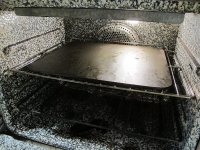"Buckwheat Honey"
I remember we used to get that quite often when I was a kid, my dad really liked it. I don't recall seeing any in years, which is odd because I know people grow buckwheat around here. Last summer we stopped in the Balmoral Grist Mill, a traditional grain mill not too far from here. Balmoral Grist Mill |
It is a "museum" but is also a functional mill. I had wanted to get some of their oat meal. Not cut or rolled oats, but oats that are kiln dried then stone ground into a coarse flour. Sadly they were out of oats (which rhymes in Canada), but they had some buckwheat flour so I got a bag of that. It makes great pancackes mixed with a bit of wheat flour, I use a little regular white flour and some whole wheat Red Fife flour. Red Fife is a fascinating story because while we know exactly who first grew it, and when, and where he got the seed, we have no idea where it really came from. The entire crop except for the shoots from a single seed all got infected with rust and withered. He planted those few harvested seeds in one corner of his field the next year and they thrived, while all the rest was blighted. Etc etc and now all modern wheat varieties have Red Fife as a progenitor species. Maybe it was a random mutation, maybe it was a single seed left in the hold of a ship which became mixed with another shipment. It might have been grown in the Levant or Ukraine or somewhere else.
Final connection: In the 19th century European grain trade was dominated by a family called Ephrussi from Odessa (of course not really "from" Odessa but allowed to live there, because Odessa was beyond the Pale of Settlement in the Russian Empire). The story of that family in the 19th and 20th centuries is documented in a book called "The Hare With Amber Eyes" (2010) by Edmund de Waal, a scion of the Ephrussis. It is fascinating and heartbreaking and I recommend that you read it. I like to think that the Red Fife seed was transported in the hold of one of their ships before being sent to Canada, making disease-resistant Canadian wheat just one more of their legacies.
I've been known to be wrong on occasions. There's room for all types. 🙂 It's best to have all 3 forms of liquid sugar around, IMO.
Sure. Iirc, I've got a sticky toffee pudding recipe around that calls for golden syrup, black treacle, honey and unrefined brown sugar. 😉
Cal -- how slack do you like your doughs for pizza?
I'm not sure. I use:
2 cups flour
1 cup water
1tbs regular yeast
1tbs oil
1tsp sugar
1tsp salt
Proof the yeast then into the mixer to knead for 6 or 7 minutes then into the Instapot on 'yogurt' setting for 30 mins. It triples in size then over to the floured cutting board it goes.
It was just something I grabbed from the internet. I guess that's why it tripled instead of doubled?
EDIT: I seemed to have combined 2 recipes inadvertently. Should have been 1.5 tsp yeast. No harm, no foul. 🙂
EDIT: I seemed to have combined 2 recipes inadvertently. Should have been 1.5 tsp yeast. No harm, no foul. 🙂
> I would use dark honey instead of molasses
Hard to beat molasses (IMO)
It's really distinctive probably does a big part
of defining the flavor of the dish.
My Grandpa used to get something called sorgum.
It had the consistancy of honey, but the flavor
of light molasses .......... HhMmmmm
For date nut bread I would stick with honey as that is more traditional in middle eastern recipes. Dark molasses certainly adds flavor when needed. Way better than Derfy's maple syrup!
Of course using either adds a bit more moisture, so some may want to reduce other liquids by a bit.
Now when making Toll House cookies I use white chocolate bits. Definitely not the ones that are not made from anything other than cocoa beans. There are some bits that are sugar and some other fat, best never purchased.
Now the white chocolate goes very nicely with the cocoa I add to the batter. Dark molasses instead of a bit of the sugar, honey works well also.
The most important step is to really mix the batter before adding the white chicolate bits. Other than those changes it is the recipe that comes on the Toll House bits bag.
The result is a fluffy chocolate colored cookie with white bits. Basically the same cookie as the classic but with the colors reversed!
> For date nut bread I would stick with honey as that
> is more traditional in middle eastern recipes.
That makes sense. Molasses is more of a ' Americas ' thing .
> is more traditional in middle eastern recipes.
That makes sense. Molasses is more of a ' Americas ' thing .
Now when making Toll House cookies I use white chocolate bits. Definitely not the ones that are not made from anything other than cocoa beans. There are some bits that are sugar and some other fat, best never purchased.
Ed you have a contrarian take on everything.! 🙂 If you enjoy this stuff do it while you can, my daughter is a baker and real vanilla and cocoa could make the endangered list in a few decades. The best quality vanilla extract can already be $500/gal to the trade.
I actually saw gelato in Italy a couple of weeks ago with a surcharge for real vanilla.
Last edited:
Anyway, it came out great.
That's the ultimate measure of a dough. 😉
8 oz H2O : ~8.5 oz Flour+a bit of everything else = ~90% hydration. Pretty wet!
Scott,
Not to worry soon we can plant cocoa in the Midwest! Usage is up, harvest is down and it is labor intensive.
So as the folks who know it is all a fake issue, we can soon graft genes into pigs to get vanilla? 😉
Yes I am aware of rising demand, decreased production and increased labor costs.
Not to worry soon we can plant cocoa in the Midwest! Usage is up, harvest is down and it is labor intensive.
So as the folks who know it is all a fake issue, we can soon graft genes into pigs to get vanilla? 😉
Yes I am aware of rising demand, decreased production and increased labor costs.
Pretty wet!
Yes, in total I needed another 1/2 cup during the kneading.
I see someone else was in the mood for Sunday pizza.
I see many of you have a good handle on baking. If I may, I'd like to draw on your experience. I can google all day but not get real world experience.
Please explain if you can.
1. Is bread flour worth the extra?
2. Regular yeast or quick?
3. Adding more than the recommended amount of oil?
4. Seasoning the dough, say with dried Italian herb mix?
5. Over rising the dough, say 4 hours instead of 1-2? (or 30 mins in the Instapot)
Thanks for your help.
Please explain if you can.
1. Is bread flour worth the extra?
2. Regular yeast or quick?
3. Adding more than the recommended amount of oil?
4. Seasoning the dough, say with dried Italian herb mix?
5. Over rising the dough, say 4 hours instead of 1-2? (or 30 mins in the Instapot)
Thanks for your help.
Among all the pizza dough recipes in Peter Reinhart's book American Pie, here is the one that I like best: his "NY Style" dough.
Attachments
Yes, in total I needed another 1/2 cup during the kneading.
I see someone else was in the mood for Sunday pizza.
Always. 🙂
I talk a big game in terms of dough making, but I sit firmly in my mother's baking shadow. While I've had success copycatting, baking is just not something I've launched into with much energy (yet).
When I started baking bread my mother told me it wasn't quite up to snuff, ask our maid as she made good bread. The maid told me the bread was among the best she had ever eaten and not to change a thing.
The bakers secret I learned was you measure the water and then add it to way too much flour and use that to make a ball. The flour that stayed loose went back to be used later. The skill is knowing what a proper ball of flour should feel like. Too soft is a bit worse than too hard. But it should be firm, not hard.
Bread flour is much better for bread than multi-purpose flour.
Now buying yeast is the easy way. The next secret is when you get a rally good piece of bread, save a bit from the center. Use this to make a starter yeast culture.
(Works for beer also.)
The bakers secret I learned was you measure the water and then add it to way too much flour and use that to make a ball. The flour that stayed loose went back to be used later. The skill is knowing what a proper ball of flour should feel like. Too soft is a bit worse than too hard. But it should be firm, not hard.
Bread flour is much better for bread than multi-purpose flour.
Now buying yeast is the easy way. The next secret is when you get a rally good piece of bread, save a bit from the center. Use this to make a starter yeast culture.
(Works for beer also.)
Last edited:
- Home
- Member Areas
- The Lounge
- The food thread





